Oyster mushrooms and angel wings are often found in similar forest environments. However, while one is edible, the other can be toxic – or even deadly! This article compares these two mushroom species so that you can learn the similarities and differences between them and know which you might eat, and which to stay far away from!
This article will go over where each of these mushrooms grows, their appearances, and some history about each. Let’s learn more about oyster mushrooms and angel wing mushrooms together now!
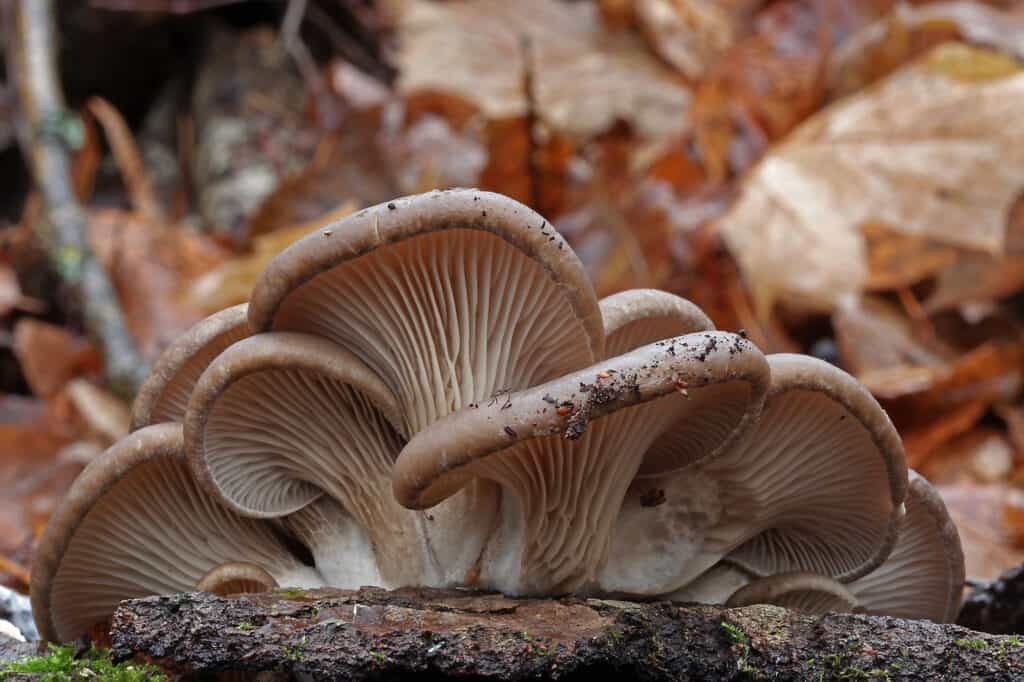
Oyster mushrooms are edible and among the most commonly consumed mushroom species in the world.
©NK-55/Shutterstock.com
Oyster Mushrooms vs. Angel Wing Mushrooms
| Characteristic | Oyster Mushrooms | Angel Wing Mushrooms |
|---|---|---|
| Scientific Name | Pleurotus ostreatus | Pleurocybella porrigens |
| Genus | Pleurotus | Pleurocybella |
| Family | Pleurotaceae | Marasmiaceae |
| Class | Agaricomycetes | Agaricomycetes |
| Division | Basidiomycota | Basidiomycota |
| Kingdom | Fungi | Fungi |
| Common Name | Hiratake, oyster mushroom, pearl oyster mushroom | Angel wing, angel wing mushroom |
| Origin | Asia, Europe, and North America | Countries throughout the Northern Hemisphere, including in Asia, Europe, and North America |
| Description of Fungus | The popular edible fungus known as the oyster mushroom is a medium-sized, oyster shell-shaped mushroom that grows in the forest throughout Asia, Europe, and North America. Oyster mushrooms have brown, gray, or off-white caps with off-white or cream-colored gills. They have very short stems and grow in clusters on dead or dying wood. Oyster mushroom caps range in size from 2 to 10 inches across. Oyster mushrooms are edible and among the most commonly-harvested and frequently-cultivated edible fungi in the world. | Angel wing mushrooms are small, white mushrooms which grow flat caps that stretch out like “wings” from a stem. They typically grow from as small as 1 inch to as long as 4 inches across. Angel wings grow in damp, mossy environments on rotting tree stumps and fallen wood. There, they appear in the summer in forest environments throughout Asia, Europe, and parts of North America. Angel wings were historically harvested and eaten from the woods. However, angel wings are now recognized to be poisonous and potentially deadly to those who consume them. |
Descriptions of Oyster Mushrooms vs. Angel Wing Mushrooms
Description of Oyster Mushrooms
The species known as the “oyster mushroom” or “pearl oyster mushroom” is the fungus Pleurotus ostreatu. This species is in the genus Pleurotus, which contains several species known as “oyster mushrooms,” though Pleurotus ostreatu is the best-known. Oyster mushrooms are the second most popular mushroom species for human consumption in the world and are widely grown across the globe. Production of oyster mushrooms is second only to the more popular Agaricus bisporus. Agaricus bisporus is the species better known as a “button mushroom” or “cremini,” depending on the stage of maturity when it is harvested.
Oyster mushrooms grow in forest environments, where they are found on the side of dead or decaying trees and logs. They grow in clusters off of the wood. Their caps are usually shades of gray or brown and grow in a shape that looks somewhat fan-like or similar to that of a real oyster shell. Oyster mushrooms also have a pleasant, somewhat “briny” flavor. This taste and shape inspired the common name of “oyster mushroom” for the species Pleurotus ostreatu.
Because oyster mushrooms grow abundantly on trees in forest environments of Asia, Europe, and North America, foragers often harvest them from the wild. However, oyster mushrooms are also relatively easy to cultivate and are produced commercially and by amateurs throughout the world. You can find oyster mushrooms at a farmers’ market or grocery store, where they are often purchased to be used in soups and sauces. Oyster mushrooms are a popular ingredient in many recipes from Asia, where many top oyster mushroom-producing countries are located.
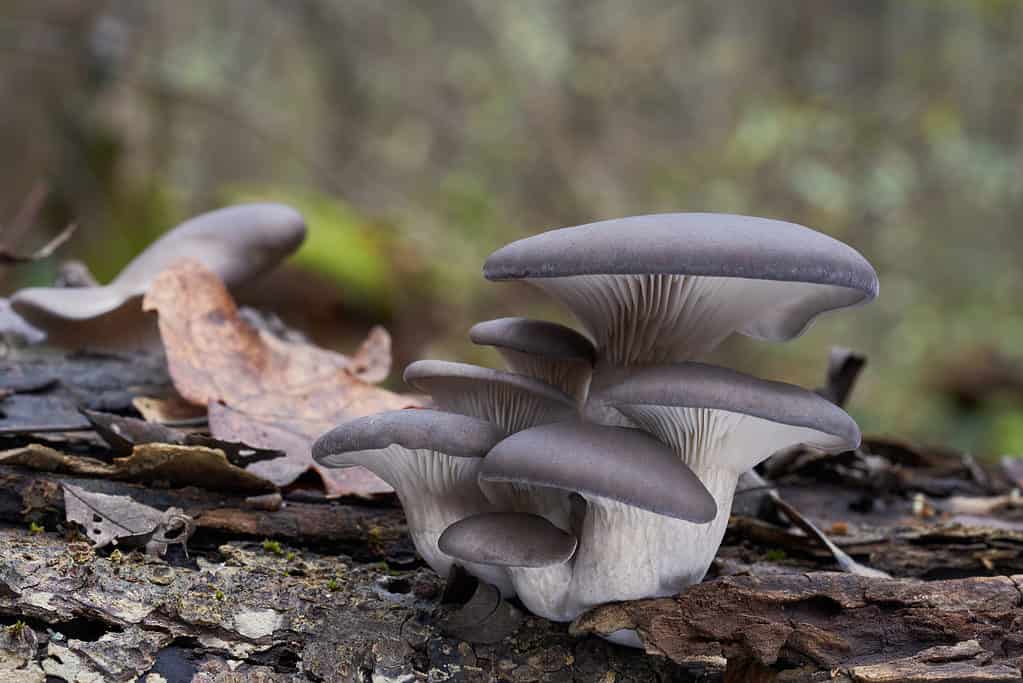
Oyster mushrooms have caps that are usually shades of gray or brown and grow in a shape that looks similar to that of a real oyster shell.
©iStock.com/Igor Kramar
Description of Angel Wing Mushrooms
The species Pleurocybella porrigens is commonly known as the “angel wing mushroom,” or simply as “angel wings.” Angel wing mushrooms have white, flat caps that grow to be 1 to 4 inches in diameter. They gained their name for the way that these mushrooms’ flat, thin caps extend outward and have a similar appearance to that of a “wing.” Like oyster mushrooms, angel wings appear in cool, damp forest environments of the Northern Hemisphere. On the continents of Asia, Europe, and North America, angel wings are a widespread mushroom species. In woodland areas in places like the United States and Canada, they grow on dying and dead wood, such as standing trees or fallen limbs.
Historically, angel wing mushrooms have been harvested from the woods by foragers to be eaten. They are said to have a mild flavor and taste. They are often confused with the edible oyster mushrooms, which grow in similar forest habitats and can have a somewhat similar color and shape. However, angel wings are not edible like oyster mushrooms. Rather, they are poisonous for humans and can be deadly if eaten.
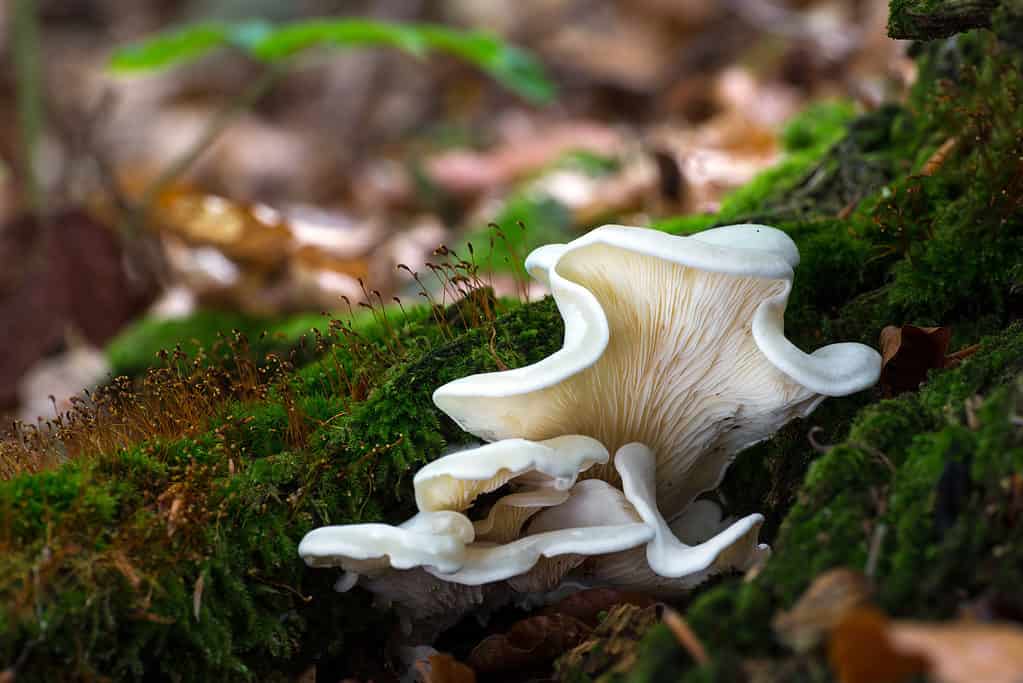
Angel wing mushrooms are currently considered to be toxic and have been linked to numerous deaths.
©Adrian_am13/Shutterstock.com
Key Differences
Oyster mushrooms and angel wing mushrooms grow in similar parts of the world on wood in forest environments. They can look a lot alike, but there are several notable differences between the two species. Let’s dive in to explore their differences in use, growing habits, appearance, and more vivid detail in the rest of this article.
Oyster Mushrooms vs. Angel Wing Mushrooms: History and Origins
History and Origins of Oyster Mushrooms
Oyster mushrooms are an important part of the world of culinary mushrooms. They are one of the easiest edible mushroom species to cultivate and one of the most commonly produced. Some people even grow them at home, using a basement or dark room to inoculate and grow oyster mushrooms to eat. Others search for oyster mushrooms in temperate forest environments where they grow natively across continents in the Northern Hemisphere.
Today, multiple species in the genus Pleurotus are cultivated to be eaten. However, oyster mushrooms may also be harvested from the wild. During World War I, when subsistence measures challenged people to find alternative food sources, oyster mushrooms became an additional source of nutrition for people suffering from food shortages. Their first documented cultivation was in the 1930s. Oyster mushrooms can be an affordable, effective source of protein and other vitamins and minerals, particularly in the absence of animal protein.
Oyster mushrooms can be easily grown throughout much of the year, explaining their popularity for commercial cultivation. They require few resources and very little technology. They have short lifespans (and so can be harvested quickly) and contain many vitamins and minerals. This makes them particularly well-suited for commercial cultivation. As a result, they have risen in the ranks to become a top mushroom in the global economy. Many top oyster mushroom-producing countries are on the Asian continent, with many farmers growing the mushrooms in China, followed by countries such as Korea, Taiwan, Thailand, and the Philippines.
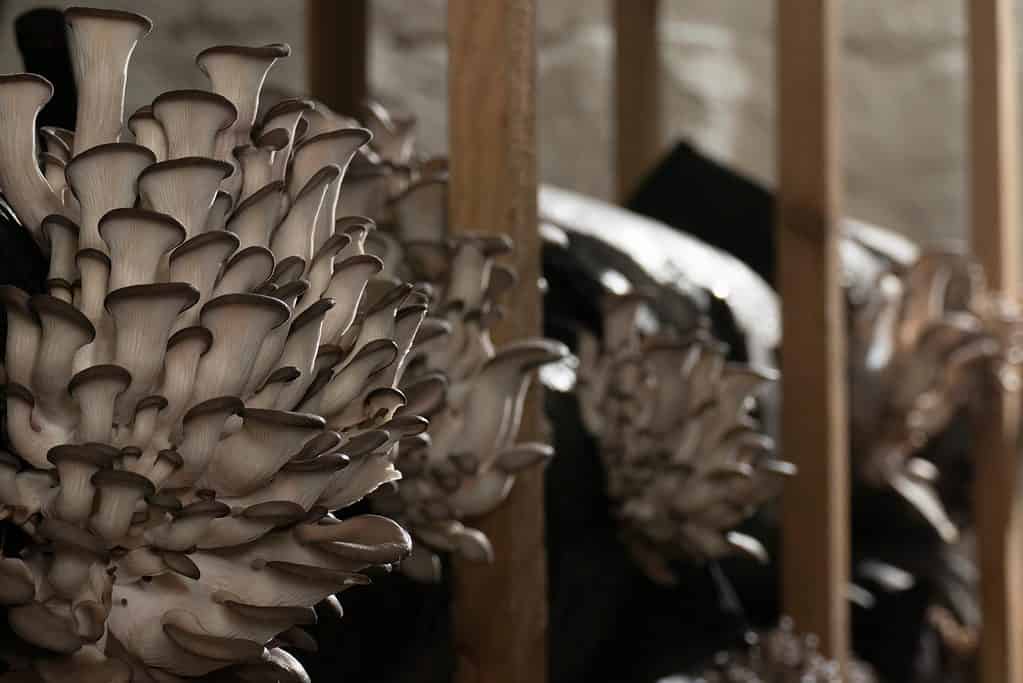
Because oyster mushrooms may be easily grown and can grow throughout much of the year, they rose in popularity for commercial cultivation.
©dimdiz/Shutterstock.com
History and Origins of Angel Wing Mushrooms
Though angel wing mushrooms are sometimes confused with oyster mushrooms, they are a different species that was initially described and placed in the scientific taxonomy in 1805. This species was originally called Agaricus porrigens and placed in the Agaricus genus, along with the button mushroom species Agaricus bisporus. However, in the 1940s, a mycologist named Rolf Singer reclassified this mushroom into the genus Pleurocybella and gave it the new and current name, Pleurocybella porrigens.
For a long time, people ate angel wing mushrooms as an edible species. The beautiful, thin, white caps are pleasant to look at and have a mild flavor. However, in 2004, angel wing mushrooms caused multiple deaths in Japan. The people who died had eaten the mushrooms. They were then diagnosed with acute encephalopathy, a degenerative neurological condition. The Japanese Ministry of Health identified the angel wing mushroom as the source of poisoning. However, scientists still do not completely understand the connection between consuming the mushroom and the development of acute encephalopathy. The deaths occurred in a specific, elderly population with other health conditions and in a particular context.
Research since this time has identified a few clues for why the angel wing mushrooms proved deadly, and some specific situations in which it may be safe to eat. However, because eating angel wings has proven fatal, experts recommend that you avoid eating them under any circumstances.
Oyster Mushrooms vs. Angel Wing Mushrooms: Appearance
Oyster mushrooms have medium-sized caps that grow to be between 2 and 10 inches across. These caps look fan-shaped. Some people describe them as looking similar in appearance to real oyster shells, with similar gray or brown color. These mushrooms have off-white gills and short stems. They grow in shelf-like clusters on dead or decaying trees.
Angel wing mushrooms are white, with thin and delicate caps. Because oyster mushrooms can be off-white in color, and both species grow on the side of standing dead wood and fallen trees, some people confuse the two. However, angel wings are a much brighter white color. While oyster mushrooms are gray or grayish-white, angel wings are bright white or ivory. Oyster mushrooms grow to be a shell shape, while angel wings are more funnel-like and thin.

Angel wing mushrooms are white, with thin and delicate caps.
©Isaenko/Shutterstock.com
Oyster Mushrooms vs. Angel Wing Mushrooms: Growing Conditions
Growing Conditions for Oyster Mushrooms
Oyster mushrooms are saprotrophic. As a saprotrophic species, they grow on dead wood and dying trees, from which they extract nutrients. Saprotrophic mushrooms need organic matter, in this case, wood, in order to survive. As they grow, they break down the wood and decompose the dead trees. This is a valuable role in the forest ecosystem, as the saprotrophic mushrooms help to “clean up” the woods. Because of this unique role in feeding on wood, you can find oyster mushrooms on dead and dying trees. However, don’t confuse oyster mushrooms for a parasitic species! While parasites attack living tissue, thereby killing the trees, oyster mushrooms simply attach to dead and decaying wood to speed up the decomposition process.
Oyster mushrooms typically develop on hardwood trees, where you can find them appearing in the spring season. You can look for oyster mushrooms on the sides of fallen logs, dead stumps, and decaying standing trees. They start off small in the spring but continue growing into large clusters throughout the summer growing season. Depending on the climate conditions, oyster mushrooms can last well into the autumn or even winter months. This long growing season makes them a wonderful candidate for foraging from the woods throughout the year. Oyster mushrooms are resilient and grow well in the damp, cool environments of North America’s forests.
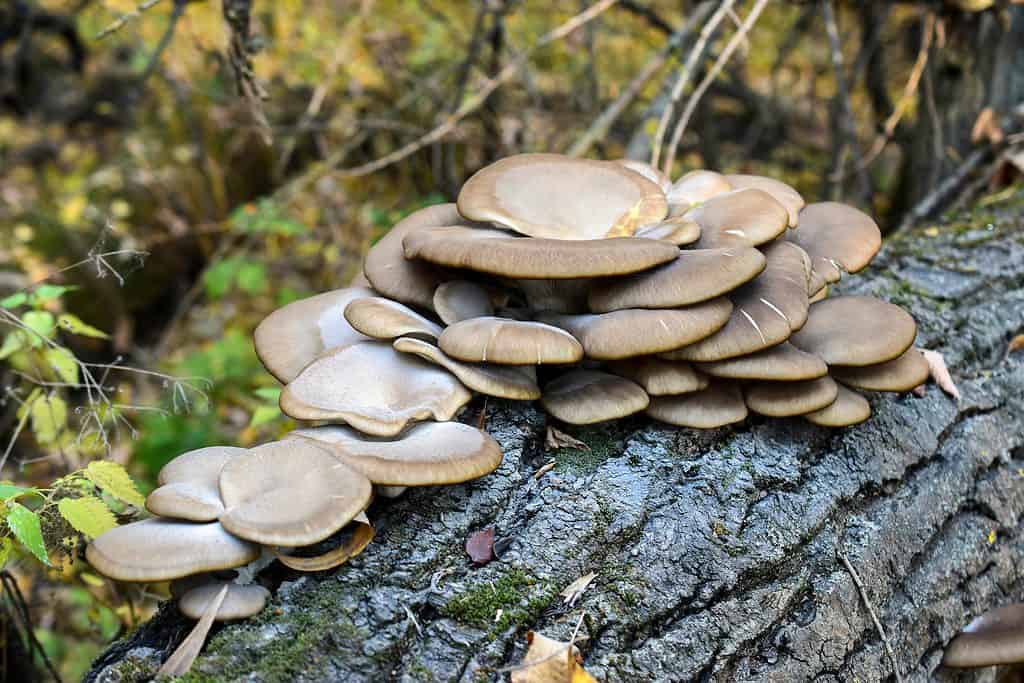
You can look for oyster mushrooms on the sides of fallen logs, dead stumps, and decaying standing trees.
©LeManilo/Shutterstock.com
Growing Conditions for Angel Wing Mushrooms
Like oyster mushrooms, angel wings are saprotrophic mushrooms that extract nutrients from dead wood and aid in the decomposition process. However, although oyster mushrooms and angel wing mushrooms both grow on dead trees and logs throughout North America’s woodlands, angel wings grow most often on conifer species. Though oyster mushrooms do occasionally grow on conifers, they prefer hardwoods. Additionally, while angel wings are common in parts of northern California and the Pacific Northwest, oyster mushrooms are notably absent from this part of North America.
Oyster Mushrooms vs. Angel Wing Mushrooms: Scent and Taste
Oyster mushrooms taste a little bit like seafood – like the real oysters from which they got their name! Some people describe them as having a briny, savory taste that is also licorice-like. When you cook oyster mushrooms, you may find that they have a meaty, chewy texture that holds up well to cooking in a soup or stew. The flavor is not overwhelming, which makes oyster mushrooms palatable to wide audiences and a favorite among foragers for their bounty and mild flavor.
In contrast, you should not ever eat angel wing mushrooms. Historically, people did harvest angel wings and eat them. However, experts can link them to deaths. Because of that, people should not consume any part of the mushroom. One way you can differentiate between oyster mushrooms and angel wings in the wild is by their scent. While angel wings have a mild, earthy scent, oyster mushrooms smell fishier or seafood-like.
Oyster Mushrooms vs. Angel Wing Mushrooms: Health Benefits and Use
Like other popular, edible mushrooms, you can gain numerous health benefits from eating oyster mushrooms. This species offers fiber and protein, as well as numerous vitamins and minerals. Oyster mushrooms contain zinc, iron, potassium, and folate. The health benefits of eating oyster mushrooms may include regulating your blood sugar, boosting your immunity to illnesses, improving your heart health, and supporting good digestion. In the present day, oyster mushrooms appear in numerous health foods and supplements as well as in recipes that call for meat alternatives. They also offer a pleasant, chewy texture and slightly briny and umami flavor making them suitable for many different sauces, stews, soups, and stir fry recipes. umami flavor to many different recipes.
As described above, angel wing mushrooms can be toxic. Some people say that angel wing mushrooms offer medicinal benefits. However, because they can also be toxic, do not eat them! Experts say that people should avoid eating angel wing mushrooms.
In Summary
Both oyster and angel wing mushrooms grow in the countries of the Northern Hemisphere, grow on the sides of dead trees, and can appear to have an off-white color. However, while oyster mushrooms are one of the most popular edible mushrooms in the world, eating angel wing mushrooms has caused multiple deaths. To tell the differences between the two, look at which tree species the mushroom is growing on, compare their scent, and look for key differences in shape and texture. You should certainly consider adding oyster mushrooms to a healthy diet – but be cautious when foraging in the woods to not mistake them for an inedible or even toxic species!
What Mushrooms Can Be Mistaken for Oyster Mushrooms?
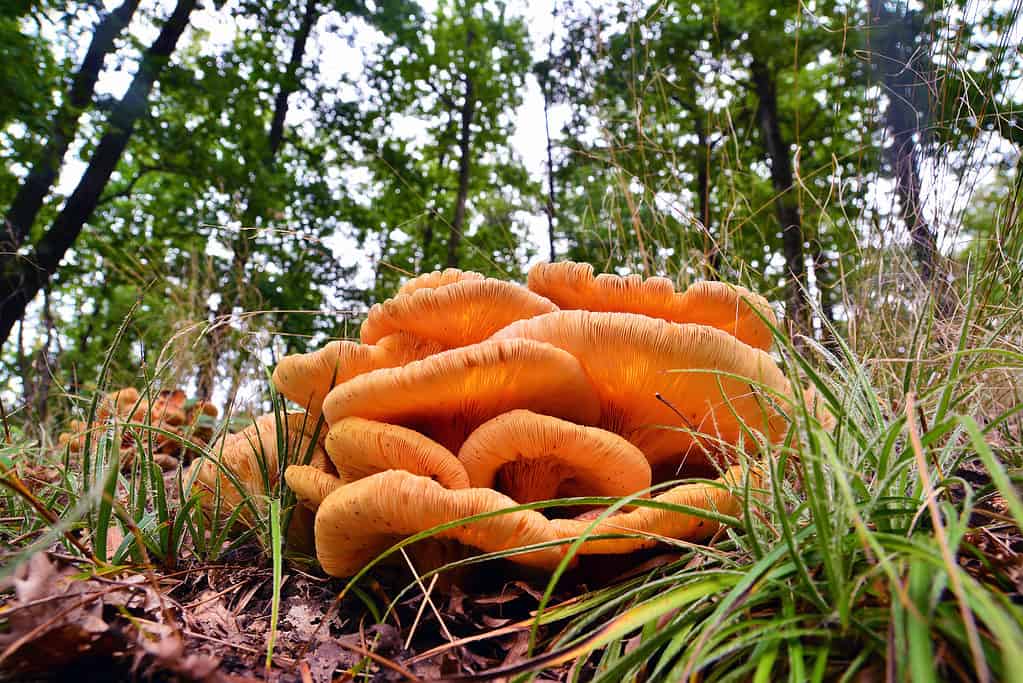
Known as the jack-o’lantern mushroom (
Omphalotus illudens), they can also be found in clusters in forests.
©iStock.com/empire331
There are over 10,000 different types of mushrooms and of these, there are around 80 that are poisonous. Should you decide to forage for these fungi, it is extremely important that you know what you’re doing, or let a professional guide you along the way. As oyster mushrooms are so popular, and may lead you on a hunting expedition, it is imperative that you determine what is an oyster mushroom and what may just be a similar one.
In addition to the angel wing, here are a few mushrooms that also look similar but should be avoided as they are highly poisonous:
- Jack-o-lantern (Omphalotus olivascens) – these are also found on dying and dead trees and logs, and have similar ‘gills’ but unlike oyster mushrooms, these can not only be found in a bright orange color, but they are bioluminescent and will glow.
- Ghost Fungus (Omphalotus nidiformis) – found mainly in southern Australia and Tasmania, as well as parts of Asia, these similar fungi also grow on decaying matter like dying trees and logs, and like the poisonous jack-o-lantern, are also bioluminescent.
- Ivory Funnel (Clitocybe dealbata) – unlike oyster mushrooms, these similar-looking mushrooms don’t grow in clusters or from the same stem and can be found in grassy areas, growing directly from the ground, not in wooded areas.
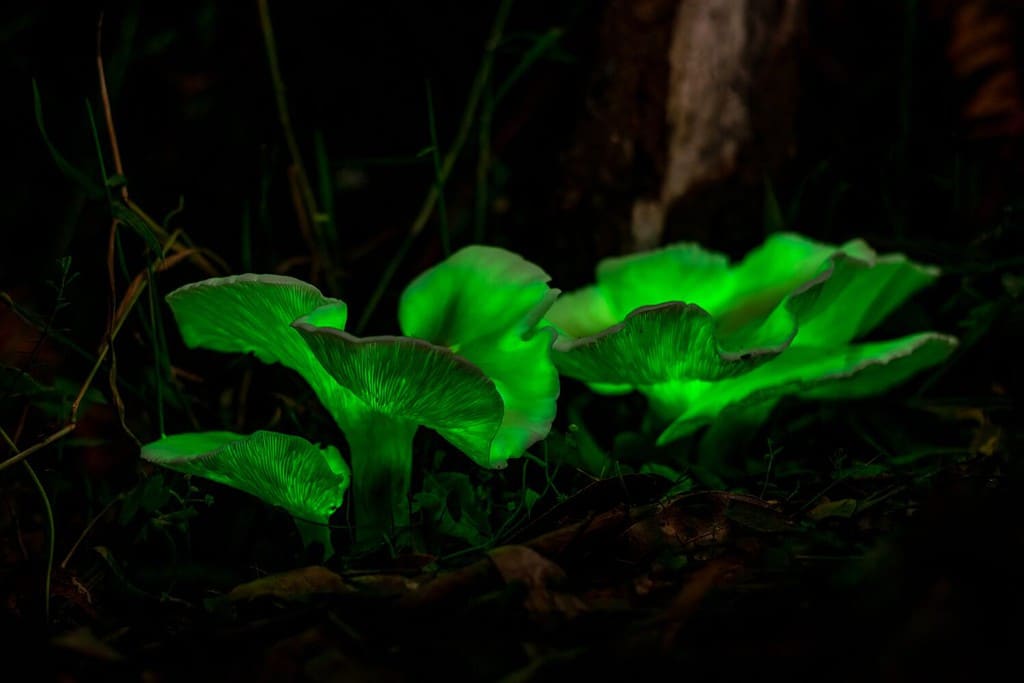
The bioluminescent ghost mushroom (
Omphalotus nidiformis) is found mainly in southern Australia and Tasmania, as well as parts of Asia.
©Petar B photography/Shutterstock.com
The photo featured at the top of this post is ©
The information presented on or through the Website is made available solely for general informational purposes. We do not warrant the accuracy, completeness, or usefulness of this information. Any reliance you place on such information is strictly at your own risk. We disclaim all liability and responsibility arising from any reliance placed on such materials by you or any other visitor to the Website, or by anyone who may be informed of any of its contents. None of the statements or claims on the Website should be taken as medical advice, health advice, or as confirmation that a plant, fungus, or other item is safe for consumption or will provide any health benefits. Anyone considering the health benefits of particular plant, fungus, or other item should first consult with a doctor or other medical professional. The statements made within this Website have not been evaluated by the Food and Drug Administration. These statements are not intended to diagnose, treat, cure or prevent any disease.
Sources
- First Nature, Available here: https://www.first-nature.com/fungi/pleurocybella-porrigens.php
- USDA, Available here: https://www.fs.usda.gov/Internet/FSE_DOCUMENTS/stelprdb5414170.pdf
- Mushroom-Appreciation, Available here: https://www.mushroom-appreciation.com/angel-wings-identification.html
- Penn State Extension, Available here: https://extension.psu.edu/cultivation-of-oyster-mushrooms
Thank you for reading! Have some feedback for us? Contact the AZ Animals editorial team.






